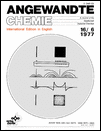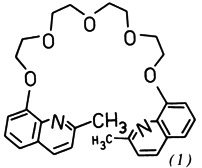Journal list menu
Export Citations
Download PDFs
Reviews
Full Access
full
Recent Applications of α-Metalated Isocyanides in Organic Synthesis†
- Pages: 339-348
- First Published: June 1977
Full Access
full
Phosphacumulene Ylides and Phosphaallene Ylides [New synthetic methods (19)]†‡
- Pages: 349-364
- First Published: June 1977
Communications
Full Access
full
Stereoisomeric Quinhydrones of the [2.2](1,4)Naphthalenophane Series†‡
- Pages: 392-393
- First Published: June 1977
Full Access
full
An Intramolecular Quinhydrone of the [2](1,4)Naphthaleno[2]paracyclophane Series†
- Page: 394
- First Published: June 1977
Full Access
full
CC Linkage of Carboxylic Acids with Allyl Alcohols Using 2-Phenylglycine as Vehicle†‡
- Pages: 394-396
- First Published: June 1977
Full Access
full
“Noncyclic Crown Ethers”: The Terminal Group Concept†‡
- Pages: 396-398
- First Published: June 1977
Full Access
full
Isolation of Isomeric Iodohydroborates of Type [B10H10-nIn]2−
- Pages: 398-399
- First Published: June 1977
Full Access
full
3,4-Bis(trimethylsilyl)benzocyclobutene—Synthesis by Acetylene Cotrimerization and Conversion into 1,2-Dihydrocyclobuta[c]benzyne†
- Pages: 399-400
- First Published: June 1977
Full Access
full
Interaction between the Nonbonding Orbitals of α-Dicarbonyl Systems and π or Walsh Orbitals†
- Pages: 400-401
- First Published: June 1977
Full Access
full
Triphenylsilylcarbyne Complexes of Tungsten†
- Pages: 401-402
- First Published: June 1977
Full Access
full
Synthesis of a Stabilized 1λ5,3λ5-Diphosphacyclobutadiene†‡
- Pages: 402-403
- First Published: June 1977
Full Access
full
New Synthetic Methods for 6aλ4-Thiapentalenes
- Pages: 403-404
- First Published: June 1977
Full Access
full
Preparation of a β-Phosphatrimethinecyanine Dye†
- Pages: 404-405
- First Published: June 1977
Full Access
full
Column Chromatography on Triacetylcellulose. Preparative Separation of Enantiomeric Diaziridines†
- Pages: 405-406
- First Published: June 1977
Full Access
full
(RPNCH3)4, Cyclotetra(λ3-phosphazanes)—Synthesis and Crystal Structure Analysis
- Pages: 407-408
- First Published: June 1977
Full Access
full
Synthesis of Dinuclear Complexes Containing PCl2 and PF2 Bridges†
- Pages: 408-409
- First Published: June 1977
Full Access
full
Reversible Transition between a [4]Radialene and a Cyclobutadiene by Electron Transfer†
- Pages: 410-411
- First Published: June 1977
Full Access
full
Symmetry and Vibrational Frequencies of Dodecahedrane†
- Pages: 411-412
- First Published: June 1977
Full Access
full
A General Method for the Synthesis of Sandwich-Type Complexes with a PdPd or PtPt Bond†
- Pages: 412-413
- First Published: June 1977
Full Access
full
Imidazolidin-2-ones by Anodic Oxidation of Conjugated Dienes in the Presence of Dimethylurea†‡
- Page: 413
- First Published: June 1977
Full Access
full
Synthesis of α,β=Unsaturated Cyclic Ketones by Sensitized Photooxidation of Silyl Enol Ethers†
- Pages: 413-415
- First Published: June 1977
Full Access
full
Crystallographic Analysis of a Topochemical Polymerization
- Page: 416
- First Published: June 1977
Full Access
full
“Carbodiphosphoranes” by a New Rearrangement of Phosphorus Ylides
- Pages: 417-418
- First Published: June 1977
Full Access
full
Reaction of Monothiodicarboximides with Phosphorous Ylides: A New Synthesis of ω-Alkylidenelactams†
- Page: 418
- First Published: June 1977
Abstracts
Book Reviews
Full Access
full
Book Review: Propellanes. Structure and Reactions. By D. Ginsburg
- Page: 420
- First Published: June 1977
Full Access
full
Book Review: Isoelectric Focusing. Edited by N. Catsimpoolas
- Page: 420
- First Published: June 1977
Full Access
full
Book Review: Mikrobiologie (Microbiology). Vol. 13 of the further education series “Medizin und Werbung” By H. Nolte
- Page: 420
- First Published: June 1977
Full Access
full
Book Review: Anorganisches Grundpraktikum (Basic Practical Course in Inorganic Chemistry). By C. Mahr and E. Fluck
- Pages: 420-421
- First Published: June 1977
Full Access
full
Book Review: Applications of Mössbauer Spectroscopy. Vol. I. Edited by R. L. Cohen
- Pages: 421-422
- First Published: June 1977






![Phosphacumulene Ylides and Phosphaallene Ylides [New synthetic methods (19)]](/cms/asset/dd2c02f5-584b-4cc7-a366-65201160c2e8/must001.jpg)


Naphthalenophane Series](/cms/asset/ae6067e9-2b02-4a9a-8c95-ef45fad6f52a/must001.jpg)
Naphthaleno[2]paracyclophane Series](/cms/asset/187e016b-a167-4dd8-a53e-9def27f5b2fb/must001.jpg)


![Isolation of Isomeric Iodohydroborates of Type [B10H10-nIn]2−](/cms/asset/953b1acf-2b79-4716-92f1-80143487107f/must001.jpg)
![3,4-Bis(trimethylsilyl)benzocyclobutene—Synthesis by Acetylene Cotrimerization and Conversion into 1,2-Dihydrocyclobuta[c]benzyne](/cms/asset/808df780-dd69-4c43-be82-4577ab2d7bf4/must001.jpg)










![Reversible Transition between a [4]Radialene and a Cyclobutadiene by Electron Transfer](/cms/asset/86de5413-5737-422a-b61d-915fe74e997f/must001.jpg)










































